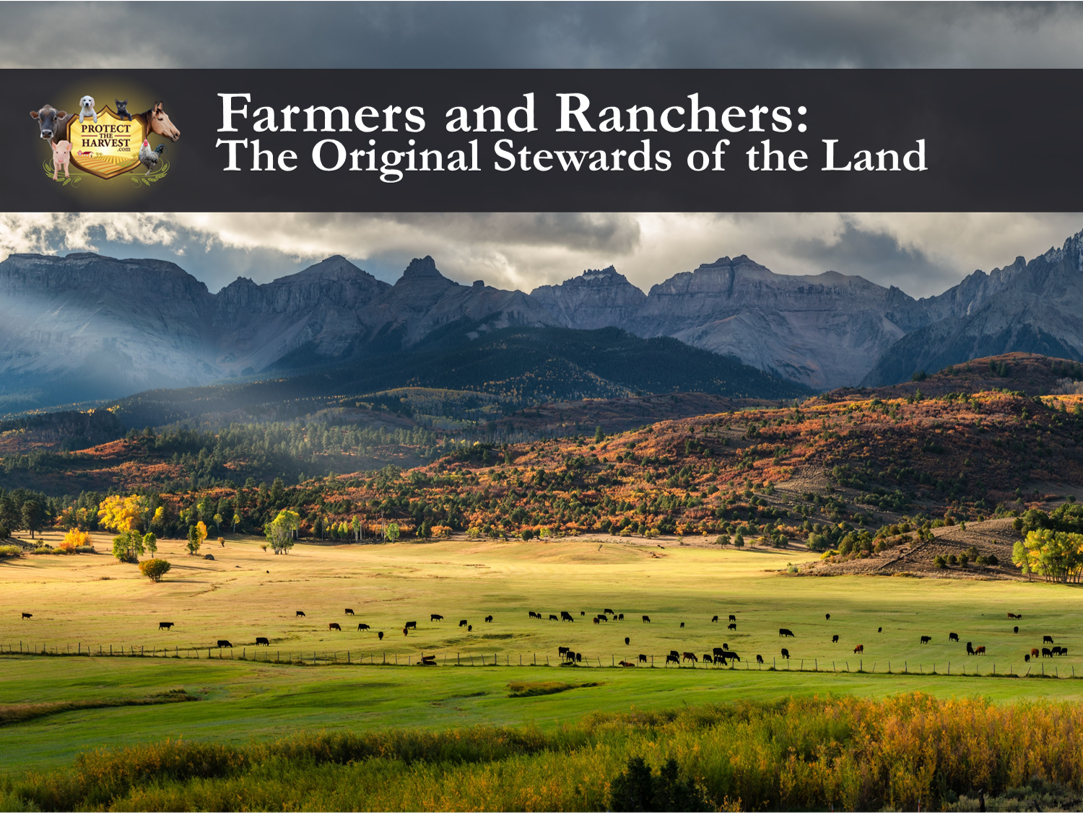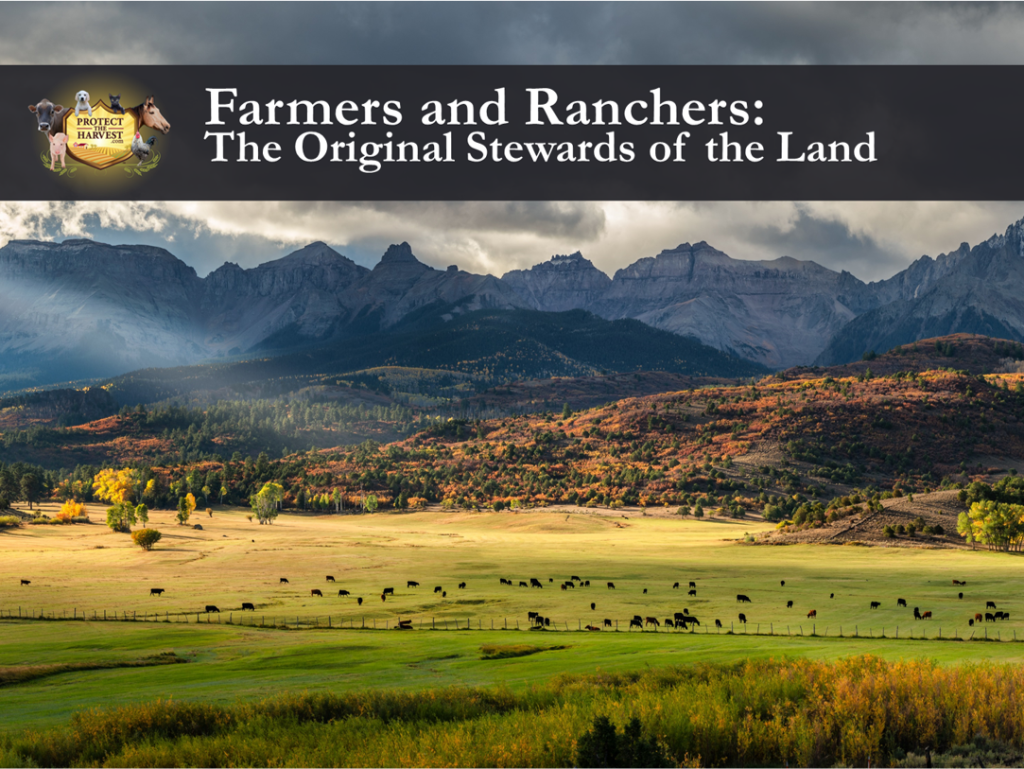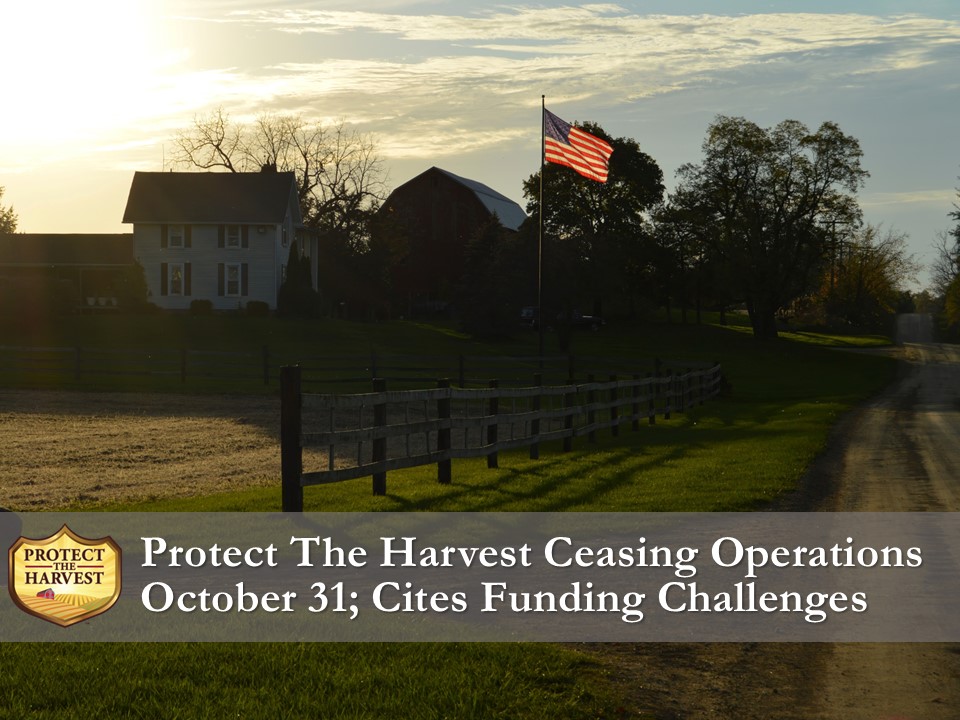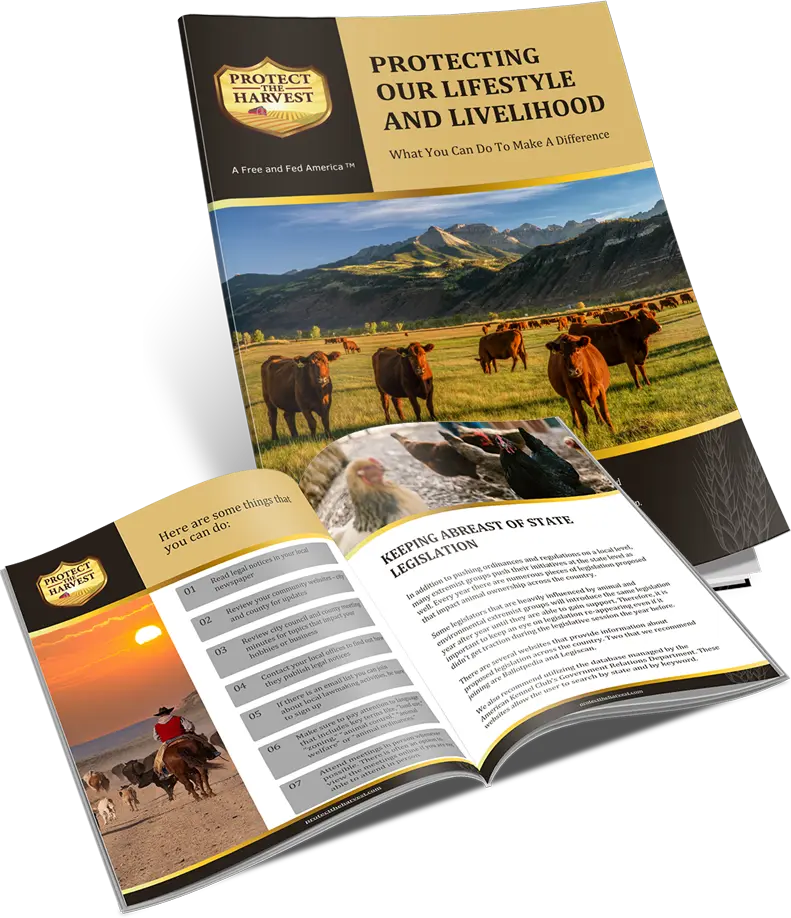
FARMERS AND RANCHERS – THE ORIGINAL STEWARDS OF THE LAND
Sustainability and good environmental stewardship are hot-button issues in today’s popular culture. It seems those who use “sustainability” most tend to present it like they invented the idea. Meanwhile, they ignore the masters of sustainability in our society: those involved in agriculture. The industry-wide practices in agriculture have significant positive environmental impacts and are not being acknowledged. In many cases these industries are being criticized for not being “sustainable” when nothing could be further from the truth.
Farming and Ranching Are Tied to the Earth
Farming and ranching are inherently tied to the earth. This makes our agriculturalists and producers some of the foremost, oldest stewards of the land. Rural communities understand this as well – with over 70% citing environmental issues as very important according to a Duke Nicholas Institute survey. For generations they have been recycling, upcycling, and reinventing all to grow more food in a sustainable way.
To read the report from Duke Nicholas Institute click HERE
A Combination of Science and Practical Experience
In recent years, agriculture has used more science and data to stretch those horizons even further while building on the lessons of the past. Unfortunately, the understanding and appreciation of the longstanding sustainability story of our farmers and ranchers has been lost. Miscommunication and false information in our media is rampant and we need to set the record straight on the irreplaceable role of agriculture in a sustainable future.
Stewardship is Essential for Future Generations
By its very nature, farming must go hand in hand with environmental stewardship. It takes hundreds of years for nature to create a single inch of topsoil. Therefore, farmers need to ensure that they take the utmost care of the land because it cannot be easily replaced. Topsoil is delicate, and to continually support a healthy crop it must be properly maintained. With 98% of farms being family-owned, most farmers desire to see their land, natural resources, water, and knowledge passed on to future generations.
Fortunately, there are many ways farmers can help safeguard their soil and these sustainable practices are used industry-wide.
For more informaiton from the Soil Science Society of America click HERE
USDA informaiton on farming and farm income HERE
Working with the Land and Scientists
Many farmers and ranchers work hand in hand with agronomists each season. They use lab analysis to get a clear picture of their land’s soil health and its nutrients. The agronomist uses this information to give accurate recommendations on what tools and practices they can use to enrich and maintain the soil.
Natural Resources Conservation Service – The Dust Bowl is In the Past
In response to the great Dust Bowl that plagued approximately 100,000,000 acres of the U.S., the Natural Resources Conservation Service (NRCS) – then the Soil Conservation Service – was established as a permanent agency of the Department of Agriculture.
Like so many other sciences, agronomy has come a long way. Sadly, some of the worst erosion in U.S. agriculture happened during the 1950s and 1970s. It was estimated that some regions experienced a loss of 20 metric tons, nearly 10 tons per acre, of topsoil each year. Since then the situation has improved greatly and starting in 1982 wind and water erosion on cropland has decreased by over 43%.
To this day this agency continues to educate farmers, ranchers, and landowners by administering programs and regulations that help preserve these valuable resources.
This is necessary not only to prevent another national tragedy but to also help farmers and ranchers do better business. Every landowner knows that taking better care of the land means a better bottom line for agriculturalists. Things as simple as tilling technique used or managed cattle grazing have a profound positive impact on the natural environment.
Information about the USDA’s Natural Resources Conservation Service HERE
Information about Soil Erosion and Conservation HERE
The Role of Grazing in Soil Quality and Wildlife Habitat
Proper grazing techniques help enhance soil quality by natural fertilization and promote more growth of healthy, younger vegetation. Grasslands can also sequester carbon and provide habitats for wildlife. In fact, one study found that land managed with strategic grazing produced 50% more invertebrates than those that did not. A similar effect was seen with habitat availability for mammals.
Informaton from the USDA Natural Resources Conservation Service regarding Prescribed Grazing SystemsHERE
Information from the Missouri Department of Conservation – Grazing for Conservation HERE
Protecting our Water
Did you know that approximately 587.76 million gallons of recycled water are used each day in American agriculture?
Water management has always been a primary concern in agriculture as it is a requirement when raising animals and vegetation. Grasslands managed with grazing can also promote conservation of this resource by increasing absorption, decreasing runoff, and building drought-resistance.
When it comes to growing crops, farmers have many advanced irrigation technologies at their disposal to carefully evaluate and measure water distribution. To be even more conservation savvy, many growers also use recycled water for their irrigation practices.
Additionally, farm ponds, waterways and streams can also help promote wildlife habitats and healthier ecosystems. Many crop farmers use conservation buffers to protect these. Buffers are areas and strips of land that are in permanent vegetation to protect waterways and reduce runoff. These buffers, according to the Natural Resources Conservation Service, remove up to 50% or more of nutrients and pesticides, remove 60% or more pathogens, and remove 75% or more sediment from making their way into our freshwater.
Information about Water Reuse in Agriculture HERE
Information about Conservation Buffers HERE
More with Less is the Key to Farm and Ranch Families Bottom Line
Agricultural efficiency is something most people don’t consider when biting into a steak or eating a fresh salad. Our farmers and ranchers can raise crops and manage livestock in ways that reduce the use of precious resources in a big way. Today it takes 75% fewer resources to produce the same amount of chicken than it did over 50 years ago. It now takes 65% less water and 90% less land for each gallon of milk produced compared to over 75 years ago. These new efficiencies make it possible to feed more people than before using fewer resources which is a big win for everyone.
When it comes to reusing and recycling, livestock farmers and ranchers are experts. Finding creative ways to do this not only helps the planet, but it also saves money and energy on the farm.
Information about sustainable poultry production HERE
Information about sustainable dairy production HERE
Reduce, Reuse and Recycle
Each farm or ranch is unique, but you will find common threads of the principles of sustainability at each to reduce, reuse, recycle, and rethink.
Fertilizers and other substances farmers use to protect crops and help them grow are very expensive. Reducing the amount of inorganic and organic fertilizer used is one way farmers cut back on expenses. Livestock producers have an especially unique advantage. Three of the primary crop nutrients – nitrogen, potassium and phosphorous – are found in animal manures.
Some farms have been able to reduce the amount of manure applied to fields with tools like manure or anaerobic digesters that concentrate nutrients with minimal waste. These types of digester systems can take the methane gas from manure processing and turns it into power sources like electricity and fuel.
If you visit a farm you may also notice how many items farmers recycle by using them in different ways. Farmers and ranchers rethink daily to find ways to become more efficient and have less waste; more waste equals more time and money that could have been used for improving efficiency.
Upcycling
Upcycling on farms and ranches is accomplished by using byproducts from other industries. A surprising 40% of feed ingredients used for livestock are in fact byproducts from other industries that would otherwise be wasted. An example of this is feeding cattle distillers grains from breweries, carrot tops, orange peels, and even almond hulls, all of which are edible and nutritious to cattle when mixed in the correct proportions with their feed.
With the right processing equipment, livestock producers can even recycle and reuse old bedding for their animals. Sand has become a very popular bedding choice for many dairies, in part because it can be cleaned with recycled wastewater water, dried and then put back in the barn.
Other common recycled items you might see on farms and ranches include things like tires, plastic containers, bailing twine, and wood pallets.
Farmers Are Trusted, So Where is the Misinformation Coming From?
It is no longer hidden that there are wealthy special interest non-governmental groups (NGOs) working to change our way of life. These groups want to change how animals are perceived and end animal agriculture and state their stances publicly. There are also groups claiming to focus on the environment and their latest push is to “re-wild” significant portions of our country which includes making the land inaccessible to humans. These animal and environmental extremist NGOs are interconnected and openly share staff projects, lawsuits, jointly write legislation and regulations.
These groups have used the internet and the production of documentaries to push their agenda forward. As many have now realized, the internet has been a breeding ground for misinformation where it can spread quickly. With very few people knowing farmers and ranchers in real life, it’s a rarity to get information straight from the source. This is why we are tirelessly working to set the record straight and correct the misinformation that is spreading like wildfire.
The truth is that sustainability isn’t a new concept in agriculture. Sustainability is woven into our food system and is continually improving. It is part of the day-to-day operation and management of farms and ranches.
Here are some of the common misconceptions and the real truths:
False Claim: Farming is Inherently Bad for the Environment
Facts: The fact is, all human activity has an impact on the climate, and all societies are contributing to global emissions. Agriculture is providing a necessary end-product for people: food. What makes agriculture an especially unique industry is that proper practices mitigate climate impact and also improve it with carbon sequestration. The report from the United Nations FAO, “Livestock’s Long Shadow,” which is frequently referred to as the definitive source for agriculture impact has been debunked and the FAO was forced to retract it. Unfortunately, groups who have an agenda to push have ignored this significant fact and continue to use it. Agriculture only provides a small percentage and animal agriculture specifically is less 4%.
As previously mentioned, other ways farming can give Mother Nature a helping hand include restoring wildlife habitats, improving soil health and reducing erosion.
For more information about carbon sequestration check out this article on the American Farm Bureau Federation website HERE
False Claim: Livestock and Meat Do More Harm than Good
Facts: The environmental impact of raising livestock is greatly misrepresented by those with an ulterior agenda, therefore, it is misunderstood by the public. In the U.S., only 4.2% of all green house gases GHGs are related to livestock production. Practices like strategic grazing and manure management go hand in hand with other environmentally-friendly farm and ranch practices.
To view the report by Dr. Frank Mitloehner, Professor & Air Quality Specialist, Department of Animal Scients, University of California Davis click HERE
Large livestock operations are required to have a comprehensive nutrient management plan or CNMP, for handling, storing and applying their manure. The required guidelines are overseen by NRCS and is the responsibility of the farmer to update and maintain.
Besides providing nutrient-dense and delicious food products, animals also provide materials for countless byproducts for many other industries. Researchers are always working on new ways to get even more out of byproducts from the production process, even using emissions like ammonia and methane.
To learn more about animal by-products click HERE
False Claim: Pesticides, Herbicides, and Antibiotics are Regularly Abused
Facts: There are numerous guidelines and practices that farmers follow when applying any sort of pesticides or herbicides to their land. More efficient use of these products also saves money and makes the cost of production much more economical.
False Claim: Antibiotics are Over Used in Agriculture
Facts: Antibiotics are expensive to purchase and administer. They are highly regulated so they are only used as directed to help prevent antibiotic resistance and wastage. All farmers and ranchers must also follow good stewardship practices regarding how medical products are stored and disposed of to keep people, animals and the environment safe.
Where to Find Factual Information
While there is an abundance of myths and misinformation regarding food production and the environment, there are also many good, factual sources available as long as you know where to look.
In addition to following our organization, others such as the Animal Agriculture Alliance, The Cavalry Group, National Animal Interest Alliance, Diary Carrie, and universities with agriculture programs have accurate and factual information available. Sources and citations should always be fact-checked to ensure they are coming from individuals, academia, and organizations actually involved with agriculture, and not from groups who have an agenda to end agriculture and animals in human care in the United States.
Looking to the Future
Thanks to dedication, scientific information, and advancing technology, farmers and ranchers are more capable than ever of doing things right to ensure there is not only a future in food production, but one better than we had before. Protect The Harvest commends and supports America’s agriculture industry leaders and workers and the true passion they have to be sustainable stewards of the land.



